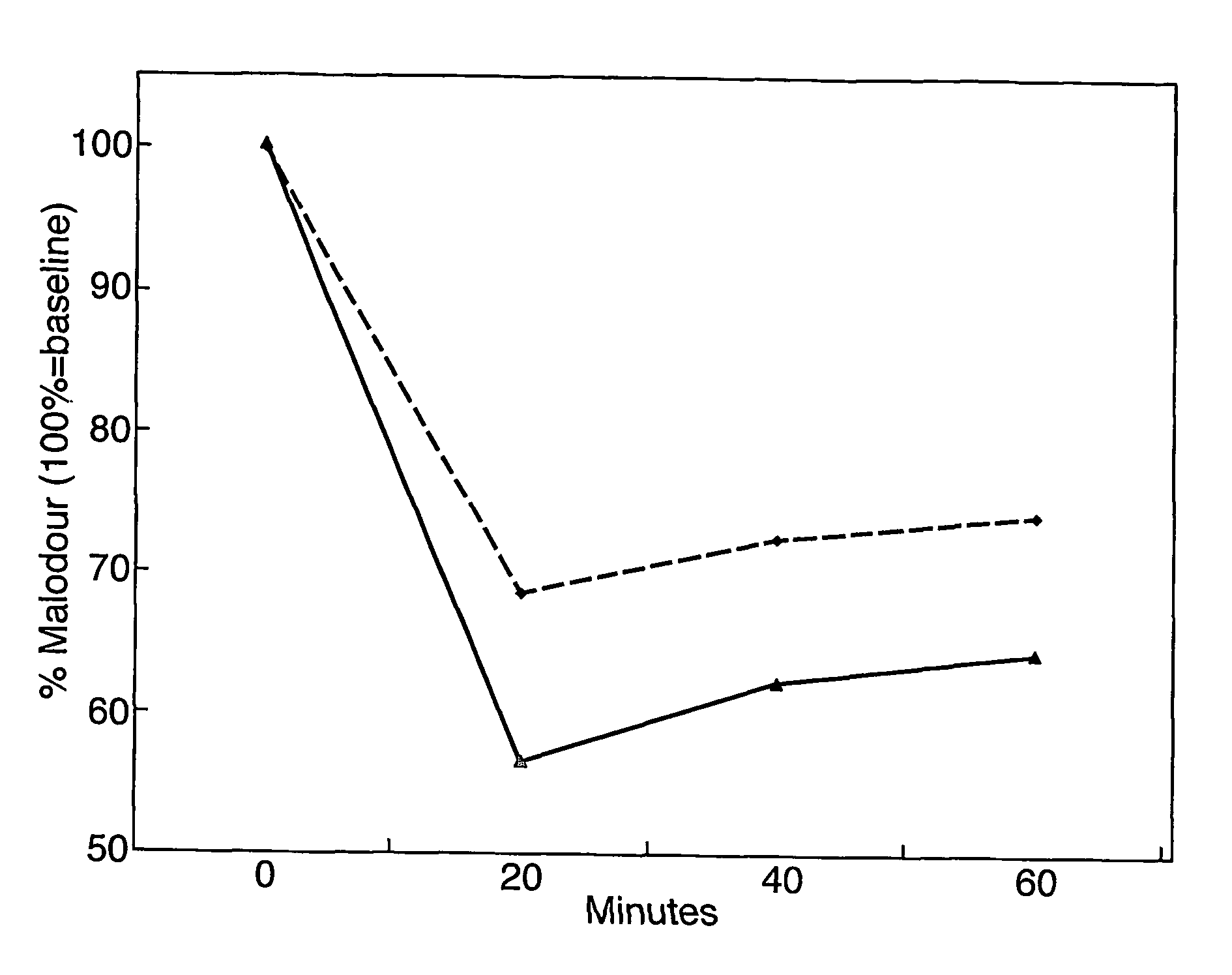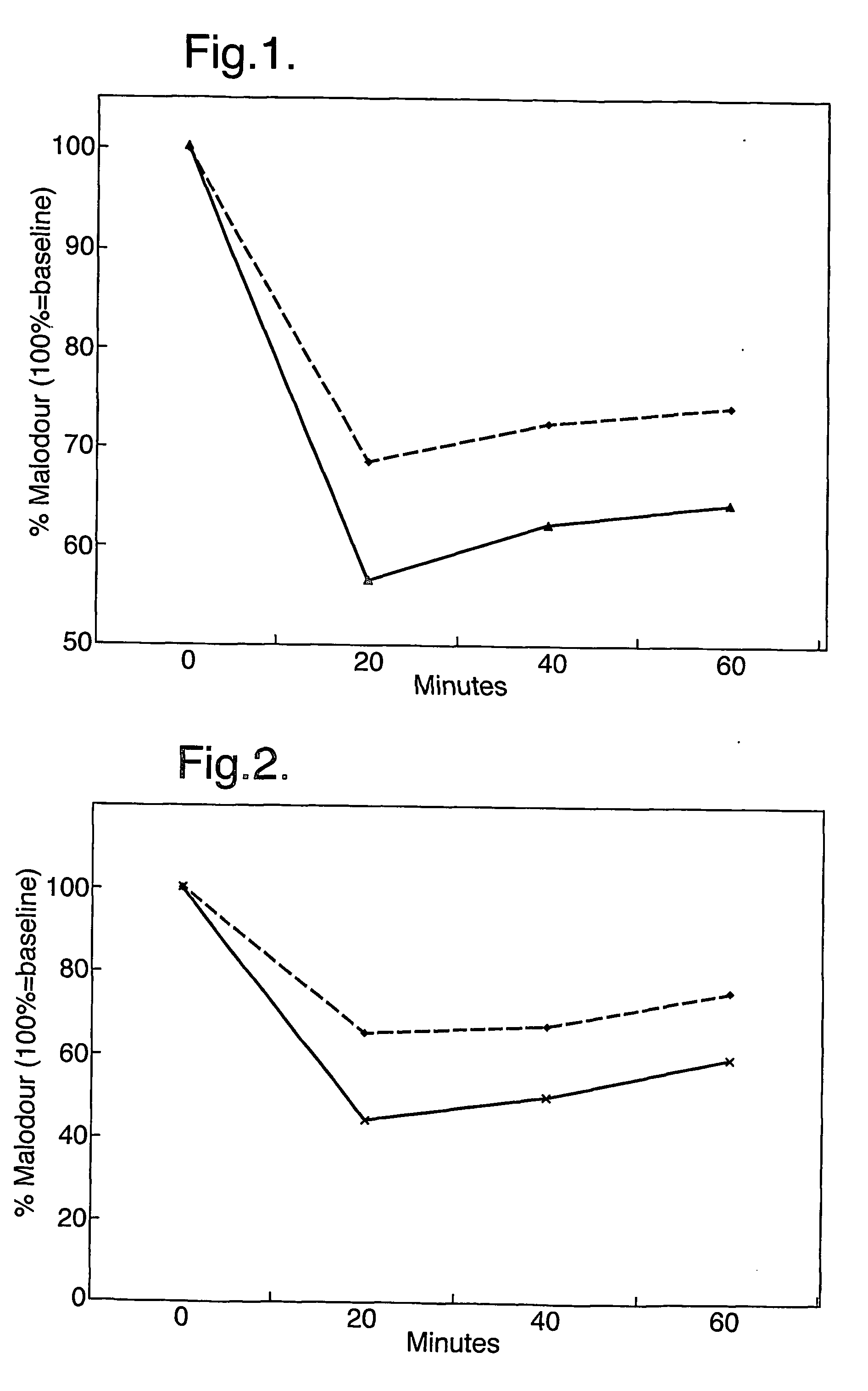Flavour compositions
a composition and flavour technology, applied in the field of flavour compositions, can solve the problems of affecting all populations, short performance, damage to the underlying tissue, etc., and achieve the effects of inhibiting the production of hydrogen sulphide, reducing or preventing oral malodor, and preventing the formation of odors
- Summary
- Abstract
- Description
- Claims
- Application Information
AI Technical Summary
Benefits of technology
Problems solved by technology
Method used
Image
Examples
example 1 (
EXAMPLE 1(b)
Anaerobic VSC Reduction Assay
[0064] The ability of a flavour material (or flavour composition) to inhibit the production of hydrogen sulphide under anaerobic conditions was determined using the following method.
[0065] A culture of the micro-organism Fusobacterium nucleatum ATCC 10953 (American Type Culture Collection (ATCC), P.O. Box 1549, Manassas, Va. 20108, USA) was inoculated into 250 ml of pre-reduced Schaedler Anaerobic Broth (SAB) (Oxoid, Basingstoke, UK) and incubated anaerobically for 48 hours.
[0066] In an anaerobic cabinet (Compact Anaerobic Workstation, Don Whitley Scientific, Shipley, West Yorkshire) headspace vials were inoculated with 9 ml of the Fusobacterium nucleatum culture (with an approximate optical density of the culture at 610 nm of 0.5 (OD610=0.5)). To each vial was added 1.0 ml of 2% w / v cysteine solution to bring the final volume in the vials to 10 ml. A stock solution of concentration 32,600 ppm of flavour material / flavour composition was pr...
example 2
Determination of Minimum Inhibitory Concentration (MIC) of Flavour Materials or Flavour Compositions
[0068] The MIC of a flavour material or flavour composition was determined by the following method.
[0069] A fresh culture of the test inoculum Klebsiella pneumoniae (as above) was diluted in sterile 0.1% special peptone solution to give a concentration of approximately 106 colony forming units (cfu) per ml.
[0070] Test samples of flavour material or flavour composition were diluted in sterile tryptone soya broth (TSB) to give an initial stock solution, typically of concentration 40,000 ppm (4% v / v). However, it will be appreciated that the concentration of the initial stock solution of flavour material / flavour composition can be varied if desired to investigate a different range of concentrations. Each row of a standard, 96-well plastic microtitre plate (labelled A-H) was allocated to one sample, i.e. eight samples per plate. Row H contained only TSB for use as a bacterial control t...
example 3
Flavour Compositions
Flavour Composition A
[0074] A flavour composition in accordance with the invention of a peppermint, spearmint, wintergreen, cinnamon nature was prepared by mixing the following ingredients.
Ingredient% w / wAnethole Synthetic*9.00Cinnamic Aldehyde Extra*3.50Eucalyptol1.00Irone Alpha (10% in propylene glycol)0.10Lime*1.50Menthol Laevo Extra35.4Methyl Salicylate8.00Peppermint American Willam Redis14.9Peppermint Indian Rectified**20.5Spearmint American Far West Scotch**6.00Vanillin0.10100.00
*Group (b) materials
**Group (a) materials
[0075] This composition gave a VSC reduction value of 67% when tested using the method described in Example 1(a) above.
Flavour Composition B
[0076] A flavour composition in accordance with the invention of a peppermint, wintergreen nature was prepared by mixing the following ingredients.
Ingredient% w / wAllyl Hexanoate*0.30Anethole Synthetic*6.50Bananate1.20Benzyl Butyrate*0.20Clove Bud Rectified Extra3.80Lime*0.80Menthol Laevo Extra...
PUM
| Property | Measurement | Unit |
|---|---|---|
| optical density | aaaaa | aaaaa |
| volume | aaaaa | aaaaa |
| volume | aaaaa | aaaaa |
Abstract
Description
Claims
Application Information
 Login to View More
Login to View More - R&D
- Intellectual Property
- Life Sciences
- Materials
- Tech Scout
- Unparalleled Data Quality
- Higher Quality Content
- 60% Fewer Hallucinations
Browse by: Latest US Patents, China's latest patents, Technical Efficacy Thesaurus, Application Domain, Technology Topic, Popular Technical Reports.
© 2025 PatSnap. All rights reserved.Legal|Privacy policy|Modern Slavery Act Transparency Statement|Sitemap|About US| Contact US: help@patsnap.com



